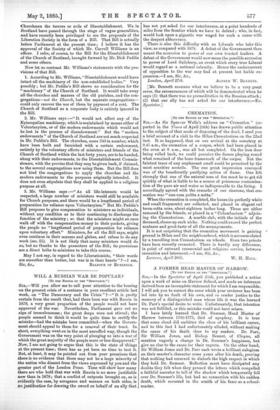CREMATION.
LTo THE EDITOR OF THE " SPECTATOR."1 Silt,—As Sir Spetcer Wells's address on "Cremation " (reported in the Times of April 24th) has drawn public attention to the subject of that mode of disposing of the dead, I send you a brief account of a visit to the Milan Crematorium on the 22nd inst. It so happened, that on our arrival at the cemetery at 9.45 am, the cremation of a corpse, which had been placed in the oven at 8 a.m., was all but completed. On the iron door being rolled back, we could perceive the flames playing routd what remained of the bone framework of the corpse. Not the faintest trace of any unpleasant smell could be perceived by the most sensitive nostrils. The one great impression conveyed was of the beneficently purifying action of flame. One felt strongly that one of the natural uses of fire must be to get rid quickly of what is liable to be a source of poisonous contamination of the pure air and water so indispensable to the living. I accordingly agreed with the remarks of our cicerone, that cremation was " una cosa polita e netta."
When the cremation is completed, the bones (in perfectly white and small fragments) are collected, and placed in elegant red terra-cotta urns, about eighteen inches long. These are either removed by the friends, or placed in a " Columbarium " adjoining the Crematorium. A marble slab, with the initials of the deceased, closes-up each niche. Nothing could exceed the perfect neatness and good-taste of all the arrangements.
It is not surprising that the cremation movement is gaining ground in Milan and the neighbourhood, which is accommodated by a travelling iron Crematorium on wheels. Even two priests have been recently cremated. There is hardly any difference, in point of outward ceremonial and religious service, between cremation and interment.—I am, Sir, &c.,
Lucerne, April 26th. W. H. HALL.


































 Previous page
Previous page